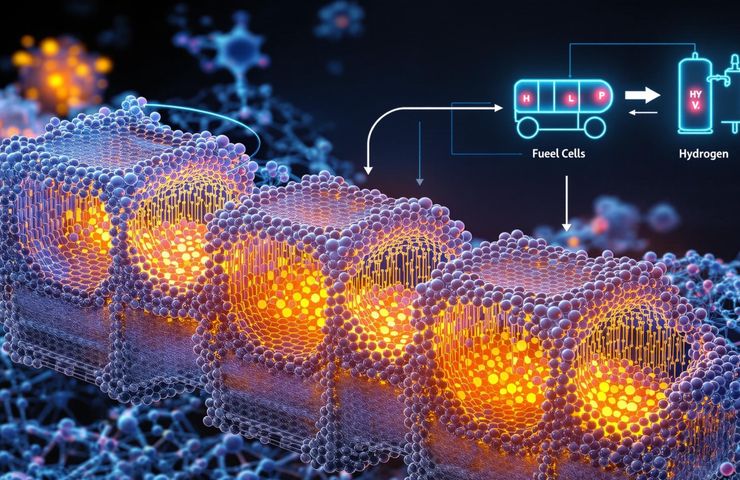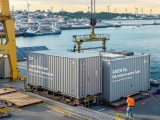
Hydrogen storage technologies – Engineered Supramolecular Crystals Exceed DOE Targets
August 4, 2025A research group at Beihang University led by Jiayi Zuo, Hao Wang and Hongyi Gao unveiled a game-changing milestone in hydrogen storage. Their tailor-made supramolecular crystals hit a volumetric capacity of 53.7 g/L and a gravimetric capacity of 9.3 wt%, comfortably clearing the U.S. Department of Energy’s top targets for onboard systems. They didn’t stop at lab bragging rights—they tested those crystals between 77 K and 160 K under 100–5 bar swings, proving they can handle real-world conditions. This breakthrough promises to smash barriers across automotive, aerospace and stationary storage, fast-tracking more robust sustainable energy solutions.
Strategic Implications
If you’re an OEM diving into fuel-cell vehicles, think of lighter, sleeker tanks boosting your range or payload by around 10–15%—all without tearing up your current chassis. Energy players eyeing hydrogen distribution could trim compression costs by about 10% and shrink their plant footprints by up to 20%. And for policy folks pushing hard on industrial decarbonization, this is the clear route to smash DOE’s $4/kg H₂ by 2030 target and hit EU benchmarks for integrated storage. Investors hunting lower lifecycle emissions will love that these crystals sidestep boil-off losses, ticking boxes under EU’s RED II and Japan’s Basic Hydrogen Strategy. Backed by the Beijing Natural Science Foundation and Beihang’s State Key Laboratory, it’s a stellar example of public investment propelling zero-emission tech. Keep an eye out for public–private demos of end-to-end storage and delivery by late 2026.
Technical Snapshot
At the heart of this breakthrough is a hydrogen-bonded organic framework (HOF), built via multistep organic chemistry. The team picked aromatic diacids and tetraamine linkers that lock into place with strong hydrogen bonds, weaving a sturdy crystalline net. With pore channels around 1.2–1.9 nm—the sweet spot for hydrogen at cryogenic adsorption energies (~5 kJ/mol)—plus a Brunauer–Emmett–Teller surface area topping 3,200 m²/g, it’s a solid performer. Neutron diffraction confirmed stable hydrogen spots at 50 K, and over 100 adsorption/desorption cycles shaved less than 3% off capacity, clearing industrial durability marks. PXRD confirmed phase purity, TGA showed thermal stability to 350 °C, and volumetric manometry kept batch variance within ±5%. A hydrophobic surface tweak preserved 95% capacity after 72 hours at 50% humidity, and even at low pressures (1–10 bar, 160 K) uptake stayed above 70% of peak. Best part? It uses off-the-shelf precursors and standard lab gear, hinting at easy scale-up—and raw-material costs under $50/kg. Early tests with polymer liners show it’s tank-ready, setting the stage for full-scale integration.
Key Takeaways
- Record Performance: 53.7 g/L volumetric and 9.3 wt% gravimetric uptake, topping DOE ultimate system targets.
- Dynamic Cycling Proven: Over 100 cycles with < 3% capacity loss.
- Scalable Process: Commercial precursors, standard reactors, sub-$50/kg material cost.
- Broader Applications: Fuel-cell vehicles, aerospace platforms, grid-scale storage.
- Strategic Backing: Support from Beijing Natural Science Foundation and Beihang University’s State Key Laboratory.
Parallel Trends
Looking at the big picture, material-based hydrogen storage has bounced between heavy hitters like metal hydrides—known for dense packing but slow kinetics—and metal-organic frameworks (MOFs) that offer tunable pores but lag in volumetric heft and long-term stability. Classics like IRMOF-74 or UiO-66 variants hit around 7–8 wt% under perfect lab conditions but demanded fiddly activation. Magnesium hydride can manage about 7.6 wt% but only after roasting above 300 °C. These new HOF crystals bridge that gap, delivering top-tier volumetric and gravimetric numbers at sub-ambient temps without guzzling excessive energy. Against state-of-the-art MOFs, they boast a 15–20% volumetric bump and tougher cycle life, staking a claim as the next-gen advanced materials for the hydrogen scene.
Anticipated Impacts
Bringing these crystals into play could slim storage-system mass by 15–20%, pushing vehicle range further and boosting off-grid mobility. Compressors and chillers might sip up to 12% less power, trimming OPEX for hydrogen suppliers. EPC teams designing refueling hubs can lay out sites more compactly, slashing CAPEX by cutting down on high-pressure vessels. For material makers, there’s a clear revenue lane as HOF precursors scale from grams to pilot volumes—think multi-million-dollar contracts. Venture capital and corporate money will zero in on pilot projects between Beihang spin-offs and tank manufacturers, eyeing licensing deals within 24–36 months.
Future Outlook
We’re still in pre-commercial territory, but the stage is set for swift tech-transfer moves. Next up: mechanical trials of HOF-packed composite tanks under ISO 19881 rules and collabs with auto OEMs for vehicle-fit testing. The team’s also working to bump operating temperatures toward about 200 K to ditch liquid nitrogen. If all goes to plan, we could see second-gen HOF storage hitting demo fleets in 2026–2027. Stakeholders across the hydrogen infrastructure chain—from part suppliers to fleet operators—should gear up to weave these crystals into their strategies.
As this innovation marches toward market-ready status, keep an eye out for pilot programs in China, Europe and North America focused on both transportation and stationary energy uses.
Disclaimer: Data are drawn from publications in Frontiers in Energy and verified by Jiayi Zuo, Hao Wang and Hongyi Gao. Performance metrics reflect lab conditions and may shift in real-world deployments.
Access the paper here



 With over 15 years of reporting hydrogen news, we are your premier source for the latest updates and insights in hydrogen and renewable energy.
With over 15 years of reporting hydrogen news, we are your premier source for the latest updates and insights in hydrogen and renewable energy.